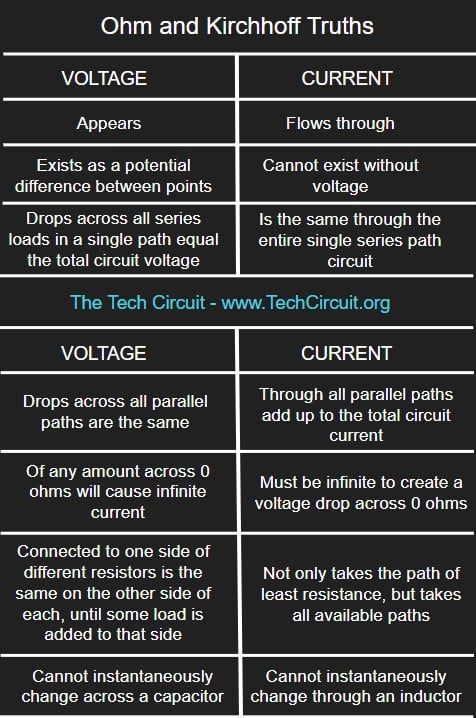Intro
It’s important to understand how electricity behaves at its most fundamental level. There are certain unwavering truths about it that will exist wherever and whenever you encounter it. Some of these root-level aspects that are relevant to field technicians are summarized in the below table and further explained in the following text.
Must-know Fundamentals

Referring to the table above, let’s go through each row step-by-step.
- Voltage appears – it will appear anywhere a conductive path has allowed it to. Voltage is an opportunist. Even the highest resistance paths will allow voltage to appear.
- Current flows through – In contrast to voltage, current is the rate of flow of electrons and is measured at a singular point in a circuit. Think of it as how much flow there is between a cross-section of a conductor like a wire or a load.
- Voltage exists as a potential difference between two points – Voltage only exists as a difference in potential. It is always measured with reference to some other point.
- Current can’t exist without voltage – Current is the result of a voltage difference across a conductive path. For current to flow, the electrons need to be attracted to a different potential. Voltage however, can exist without current.
- Voltage drops across each series load in a single circuit equal the total voltage – the voltages of all the loads in series add up to the total voltage (with resistive loads).
- Current is the same through the entire series circuit – the rate of electron flow is the same throughout the entire series circuit. The current supplied is equal to the current that is returned.
- The voltage across all loads in a parallel circuit is the same – Since each load is connected to each side of the voltage potential, they must be the same voltage.
- Current through parallel paths equal the total circuit current – Current splits up among all parallel loads and comes back together as the total current, at the return path.
- Voltage of any amount across zero ohms causes infinite current to flow – What? That’s Ohm’s law. In reality, zero ohms rarely exists. However, if you try to pass current through a wire, you’ll get lots of current!
- Current must be infinite to cause a voltage drop across zero ohms – Also Ohm’s law. Since zero ohms is hard to come by however, you can create a small voltage drop across a wire with enough current.
- The voltage on either side of a resistor is exactly the same unless a load is placed on the opposite side of the source – Ohm’s law again. Where there is no load there is no current flow. Where there is no current, there is no voltage drop, and no voltage difference.
- Current takes not only the path of least resistance, but all paths – Current is also an opportunist. It will flow wherever it can in a parallel circuit. Yes, more will flow through the lower resistances, but some will flow through all paths, including high resistance ones.
- Voltage cannot instantaneously change across a capacitor – Doing so causes infinite current to flow into that capacitor. This is an ideal capacitor of course. The ESR or any other lead resistance keeps this from happening in reality. However, a lot of current will flow regardless. This is why you hear a “pop” when discharging a cap with a screwdriver. Why? Because capacitors resist changes in voltage. This makes them useful for storing energy and “decoupling” DC circuits like in amplifiers (to name only a handful of their many applications). This resistance to voltage change causes capacitive “reactance”, and is measured in ohms.
- Current cannot instantaneously change through an inductor – Inductors resist current flow. This is one reason that you have less current flowing through a coil with AC voltage than with DC voltage. It is also why inductors are used in noise filters (and a plethora of other applications) that benefit from this fact. That resistance to current change is also called “reactance”, and is measured in ohms.
Summary
Understanding how electricity works at its most basic level will be one of the best tools a field technician will have when troubleshooting circuits. Even though each aspect of electricity in itself may not apply to all diagnostic cases, a solid understanding of the basics provides the needed awareness to solve even the more difficult electrical challenges.
The field multimeter I recommend for Appliance Technicians is the Klein CL800:
Don’t forget:
“Diverting 10 min/day of social media time towards learning something new, is 5 hours of newfound monthly knowledge.” – SM
To DONATE to the Tech Circuit – CLICK HERE
Alphabetical Links to all Tech Circuit Articles and Blogs – CLICK HERE
Links to all Tech Circuit Cheat Sheets/Field References for Appliance/HVAC Techs – CLICK HERE
For additional electrical and electronics learning material for field techs, visit our homepage at http://www.TechCircuit.org or our Facebook group at https://www.facebook.com/groups/746823709133603.
We are a participant in the Amazon Services LLC Associates Program, an affiliate advertising program designed to provide a means for us to earn fees by linking to Amazon.com and affiliated sites.
